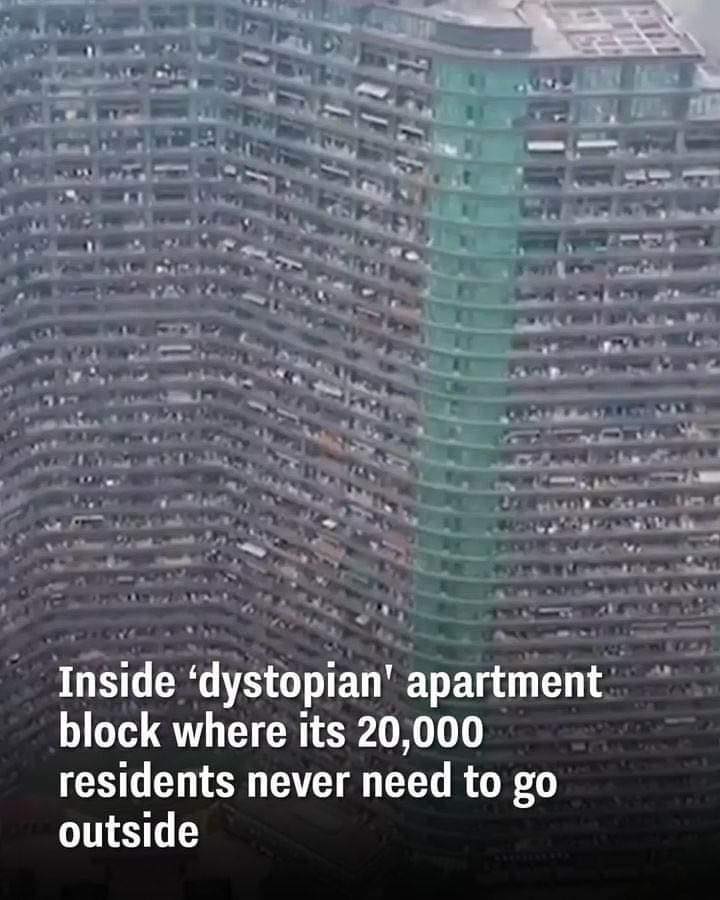A viral TikTok video has taken the internet by storm, showcasing a massive residential building in China dubbed the “Dystopian Apartment.” Captured by user @fatheristheone using a drone, the footage highlights the building’s stunning size, unique design, and impressive interior amenities. While many were amazed by its scale and modern facilities, the video sparked conversations about the implications of such densely populated living spaces, raising both awe and skepticism among viewers.

The apartment block, officially known as Regent International, is located in Qianjiang Century City, Hangzhou. Designed by Alicia Loo, the chief architect behind the renowned Marina Bay Sands Hotel in Singapore, Regent International was completed in 2013. It stands at an impressive 675 feet tall and can house approximately 20,000 residents, with the capacity to accommodate up to 30,000 at full occupancy. The building’s eye-catching S-shaped structure, spanning between 36 and 39 floors depending on the side, has made it one of the most densely populated residential areas in the world.
Despite its nickname, the “Dystopian Apartment,” life inside Regent International is far from bleak for most of its residents. The building is equipped with a wide array of amenities that cater to the everyday needs of its occupants, essentially functioning as a self-contained micro-city. Inside, residents have access to grocery stores, restaurants, internet cafes, and even nail salons. For leisure, the building offers swimming pools, gyms, and various recreational areas, ensuring that individuals can enjoy a high level of convenience without ever needing to step outside.
The appeal of Regent International lies in its practicality and affordability. Many of its residents are young professionals, influencers, and college students who are drawn to its cost-effective and convenient living arrangement. Rent prices vary based on unit size, ranging from 1,500 RMB (approximately $200) to 4,000 RMB (just under $600) per month. This affordability, combined with the availability of on-site amenities, makes the building an attractive option for those looking to live in the heart of a bustling city without sacrificing convenience or financial stability.
While the idea of living in such a densely populated environment might raise concerns for some, it’s important to note that residents are not forced into isolation or restricted from leaving the building. Critics argue that the “dystopian” label stems from fears of living spaces that lack fresh air, sunlight, or human connection—concepts often depicted in dystopian novels. However, for those residing in Regent International, the experience is far less ominous. The building’s efficient design and resourceful use of space address the needs of its population, offering a modern solution to urban overcrowding.
The innovative design of the Regent International apartment has even earned praise for its sustainability. It is often described as “one of the most sustainable living buildings on earth,” as its compact design reduces land use and optimizes shared resources. This concept of vertical living not only maximizes space but also provides a glimpse into how future cities could address housing challenges in densely populated areas.
Interestingly, similar ideas have already been explored outside of China. For instance, in Whittier, Alaska, a 14-story building serves as a self-contained community for its 272 residents. Originally built as a military installation, the structure has been transformed into a mixed-use building that includes residential units, a church, school, post office, and even a police station—all under one roof. Much like Regent International, this innovative use of space has created a compact yet functional living environment.
In light of the ongoing housing crisis in the United States, concepts like the Regent International apartment block could offer an intriguing solution. With land scarcity becoming a pressing issue, densely populated buildings equipped with essential amenities may provide a path forward for urban planners and developers. By creating self-sustaining communities in vertical spaces, cities could accommodate growing populations without compromising on comfort or accessibility.
Despite initial skepticism, Regent International has demonstrated that “dystopian” is often a matter of perception. While some view the building’s massive scale and high population density as unsettling, others praise its practicality, affordability, and innovative design. For its residents—who often lead busy, modern lives—the convenience of having everything they need within walking distance outweighs any perceived drawbacks. The building represents a shift in how we think about urban living, emphasizing efficiency, shared resources, and a sense of community.
At its core, Regent International challenges traditional notions of housing by presenting an alternative model for sustainable urban living. It may not be for everyone, but for those who value affordability and convenience, it offers a unique solution to the growing challenges of city life. By integrating essential amenities, recreational spaces, and efficient use of land, the building has become a blueprint for how densely populated cities might look in the future.
Ultimately, the “Dystopian Apartment” raises an important question: Could this model become the norm as cities continue to grow and evolve? With innovations like Regent International and similar developments worldwide, the idea of vertical, all-in-one living spaces may become more common as urban planners seek to address the needs of a booming population. Whether viewed as dystopian or visionary, the Regent International apartment block serves as a thought-provoking example of how the future of housing might take shape in an increasingly crowded world.





